Schumacher BossCat Comp Rebuild
Discussion
All,
My 13 y/o son is doing engineering at school, and wanted an engineering based project that he could do himself. He's been helping me a bit with my steam engine build (basic marking out, milling, turning etc under supervision), and has done some 3D modelling (Fusion) and 3D printing. He's also pretty capable in building and painting scale models (mainly Warhammer).
I thought a good prospect would be an old 1:16 Tamiya RC tank chassis off EBay, but they only seem to come up rarely in a state that needs some attention, and at a reasonable price.
My friend heard about this, and has donated an old RC car. He was given it a while ago and never did anything with it. He thinks it's a Schumacher CAT 2000 (possibly EC). It's a prime candidate for stripping, cleaning, evaluating and re-building:
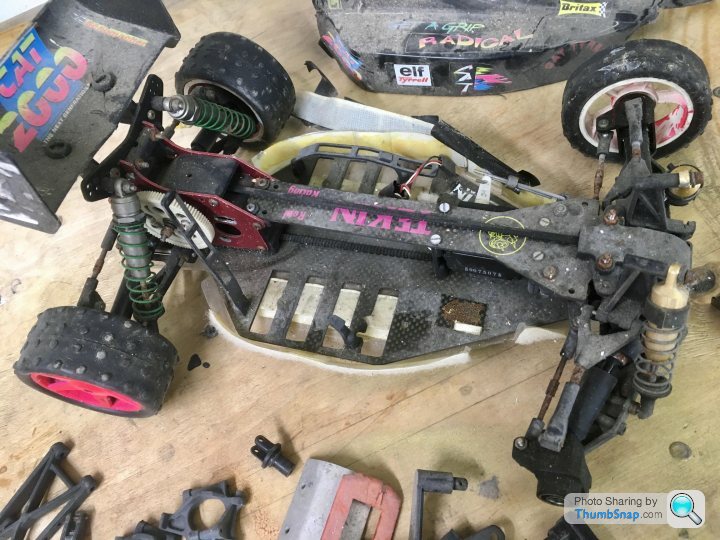
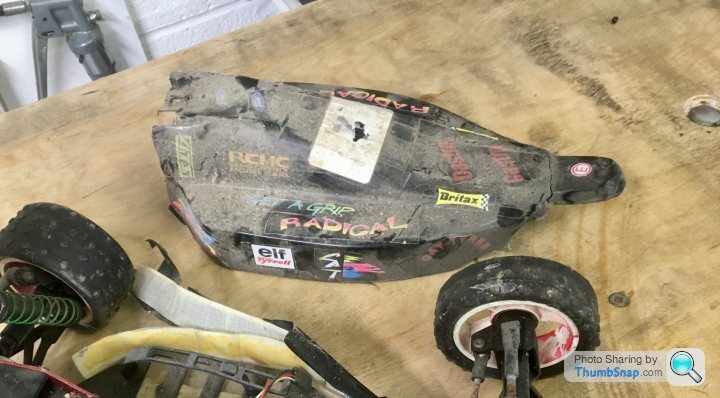
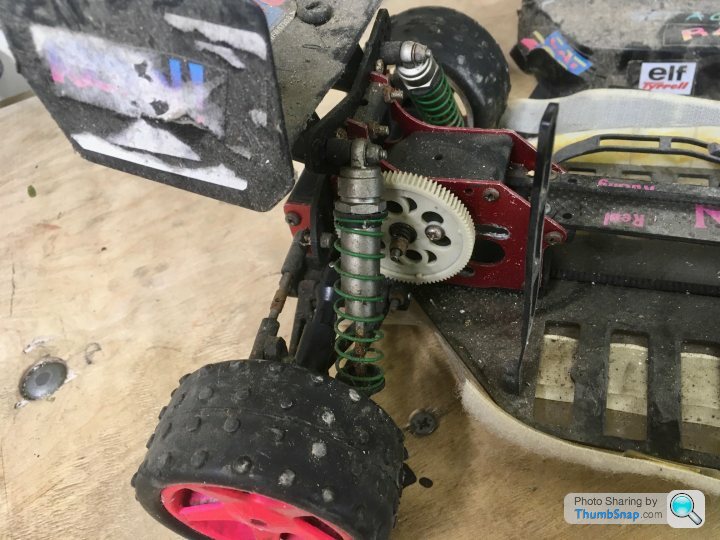

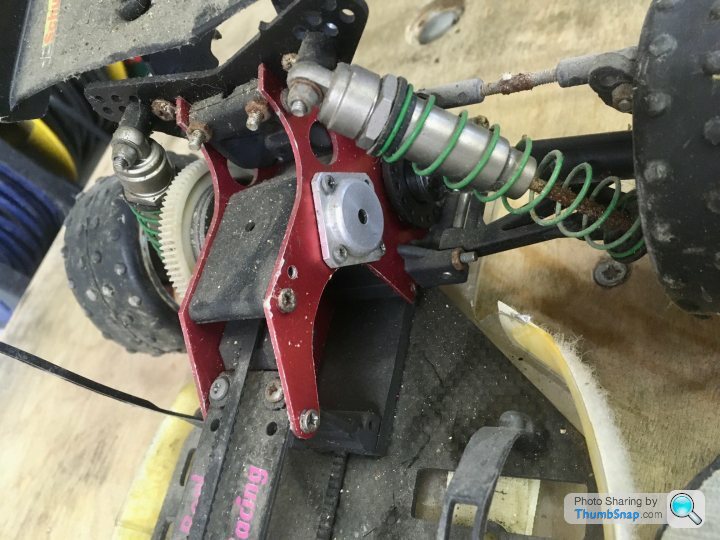
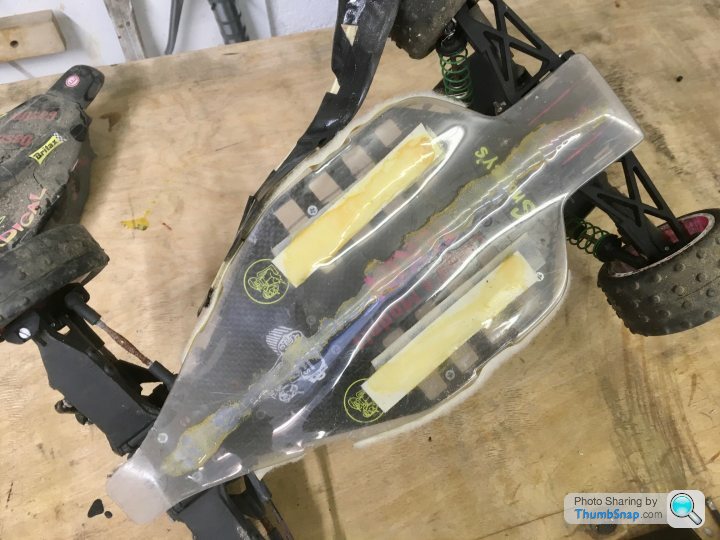
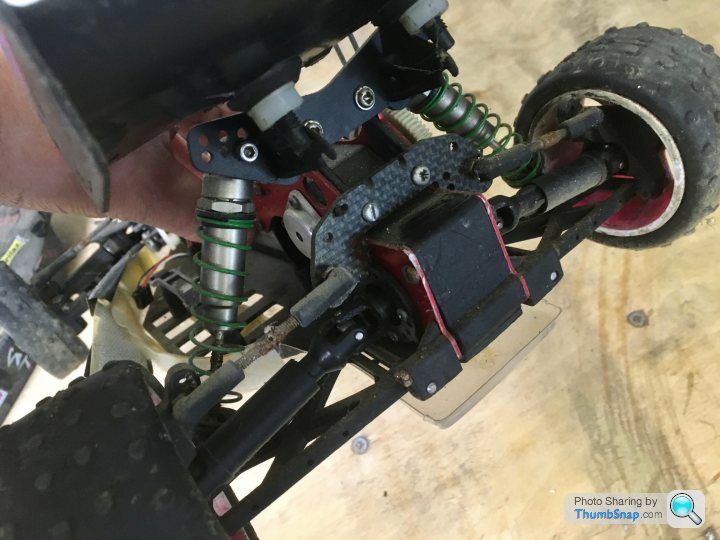
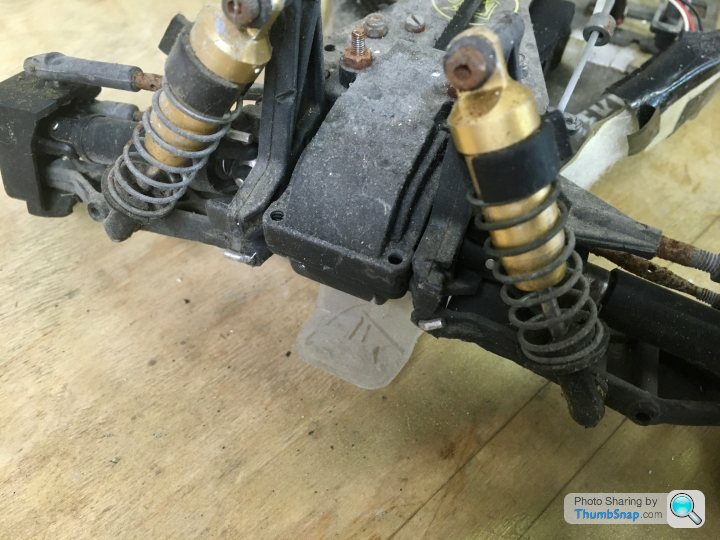
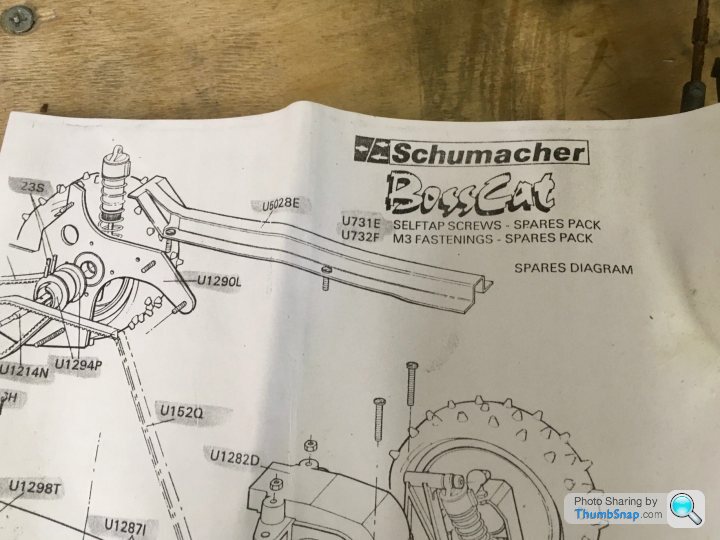
I have built and rebuilt several Tamiya RC cars, but know nothing of Schumachers.
So:
What car are we dealing with here? Is it half decent?
Are instructions / parts diagrams available?
Are spares available, if so, where is the "go-to" supplier?
Although the economics of restoring this are secondary (within reason) to the process of restoring it - are spares expensive? It would be great if we could also design/reverse engineer and make some parts if necessary.
What battery/esc/motor/wheels/tyre combination is good for a general back garden hack?
Any comments advice is welcome. Cheers.
My 13 y/o son is doing engineering at school, and wanted an engineering based project that he could do himself. He's been helping me a bit with my steam engine build (basic marking out, milling, turning etc under supervision), and has done some 3D modelling (Fusion) and 3D printing. He's also pretty capable in building and painting scale models (mainly Warhammer).
I thought a good prospect would be an old 1:16 Tamiya RC tank chassis off EBay, but they only seem to come up rarely in a state that needs some attention, and at a reasonable price.
My friend heard about this, and has donated an old RC car. He was given it a while ago and never did anything with it. He thinks it's a Schumacher CAT 2000 (possibly EC). It's a prime candidate for stripping, cleaning, evaluating and re-building:









I have built and rebuilt several Tamiya RC cars, but know nothing of Schumachers.
So:
What car are we dealing with here? Is it half decent?
Are instructions / parts diagrams available?
Are spares available, if so, where is the "go-to" supplier?
Although the economics of restoring this are secondary (within reason) to the process of restoring it - are spares expensive? It would be great if we could also design/reverse engineer and make some parts if necessary.
What battery/esc/motor/wheels/tyre combination is good for a general back garden hack?
Any comments advice is welcome. Cheers.
Extremely competant racing cars, not really designed for "backyard bashing".
Still going
https://www.racing-cars.com/
Website is full of info for both current and old models, inc manuals, exploded parts diagrams.
Spares available for old models.
Still going
https://www.racing-cars.com/
Website is full of info for both current and old models, inc manuals, exploded parts diagrams.
Spares available for old models.
sgrimshaw said:
Extremely competant racing cars, not really designed for "backyard bashing".
Still going
https://www.racing-cars.com/
Website is full of info for both current and old models, inc manuals, exploded parts diagrams.
Spares available for old models.
Thanks.Still going
https://www.racing-cars.com/
Website is full of info for both current and old models, inc manuals, exploded parts diagrams.
Spares available for old models.
Could the performance be “de-rated” by fitting a crappy motor? Or are you suggesting the entire chassis setup isn’t right for anything other than RC race tracks?
That’s a boss at which was the predecessor to the Cat2000 and 2000EC. I raced all 3 of them back in my youth.
They’re all pretty robust and the crashback feature of the front suspension saves more than a few broken front arms.
The weakness on these for me was always the driveshaft spiders which could be brittle and had a habit of shearing if you did full throttle landings from high jumps.
They’re all pretty robust and the crashback feature of the front suspension saves more than a few broken front arms.
The weakness on these for me was always the driveshaft spiders which could be brittle and had a habit of shearing if you did full throttle landings from high jumps.
I had a Pro Cat which from memory was a generation or two before this. From the photos, the most obvious job is that a strong elastic band is required across the front of the wishbones so that they only fold back when hit hard from the front. I was never completely convinced that this crashback feature didn't lead to dynamic changes in the suspension geometry but then I was a cynical teenager.
Not immediately obvious is that the belt drive system is bevellled. Unlike other systems, there are no side guards on the pulleys. At rest, it will always look as if the belt is about to fall off the side, regardless of tension. At speed, it will centre itself. Remember it took me a whie to figure that out.
Someone will be along with a suggested modern motor etc.
Not immediately obvious is that the belt drive system is bevellled. Unlike other systems, there are no side guards on the pulleys. At rest, it will always look as if the belt is about to fall off the side, regardless of tension. At speed, it will centre itself. Remember it took me a whie to figure that out.
Someone will be along with a suggested modern motor etc.
So he’s stripped it to pretty much component level:
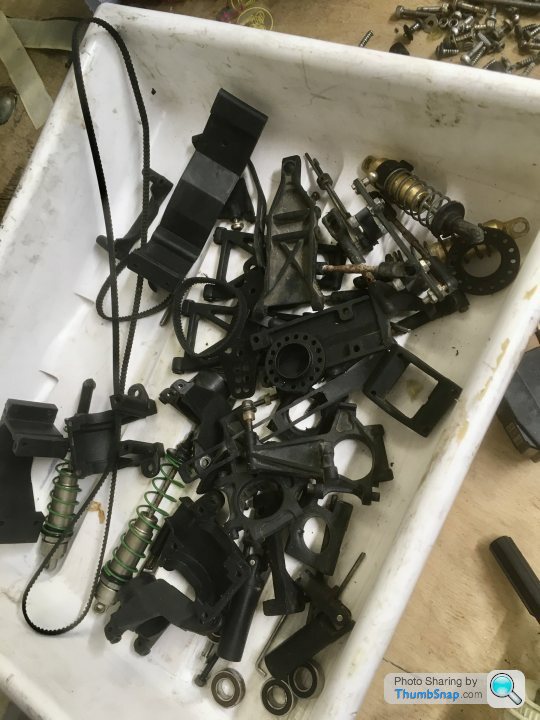
Shocks aren’t original and seem knackered, so they’ll need replacing.
Also some of the ball races have lost their shields. Might as well get a full bearing kit.
Total mish-mash of fasteners, so they’ll need replacing too.
The carbon parts cleaned up nicely:
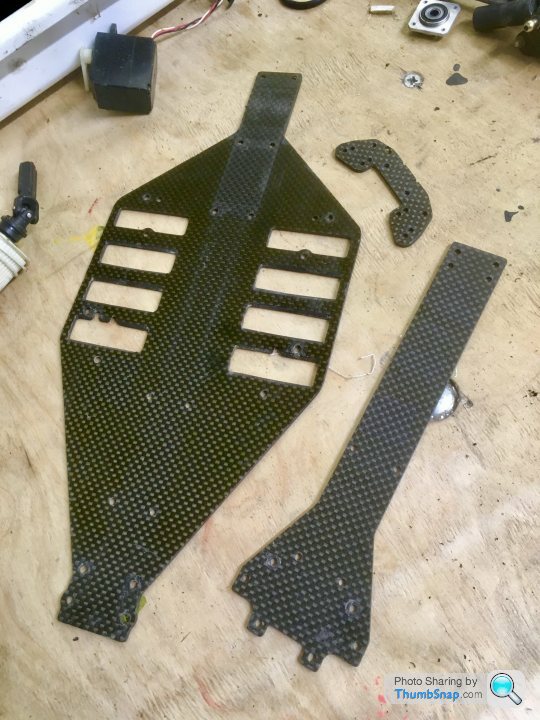
The pulleys have spacers on this one. The belt is damaged so will be replaced:
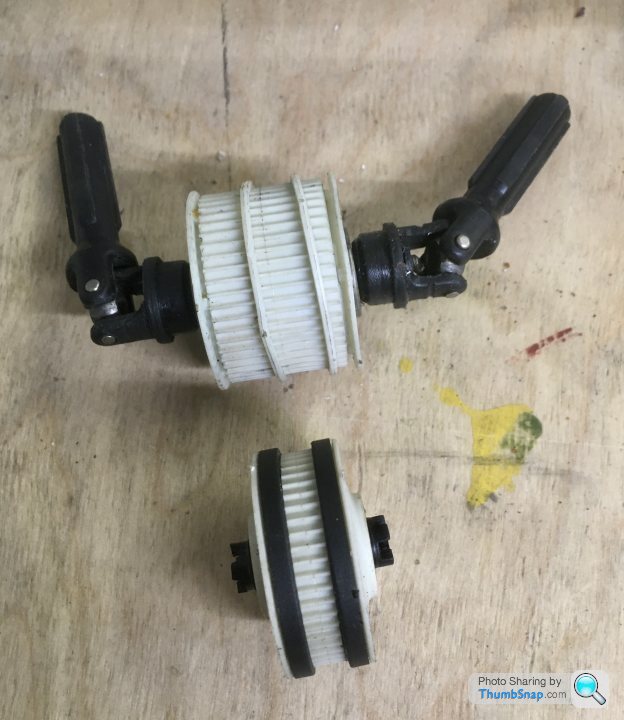
One of these pulleys is a bit chewed:
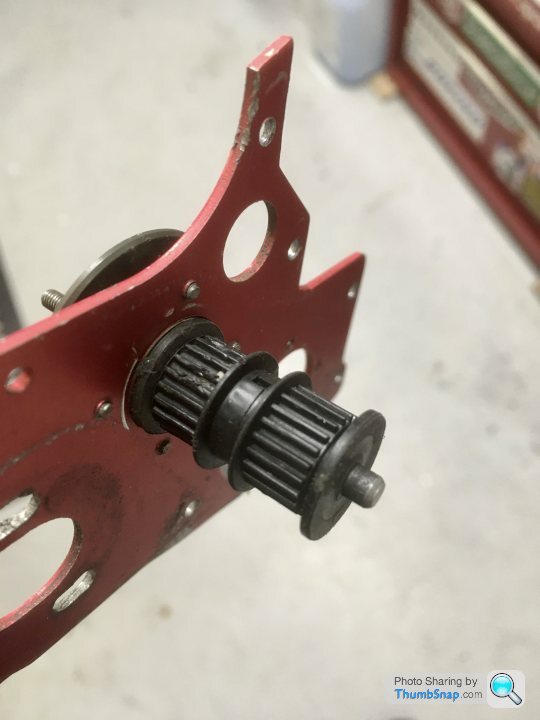
This is some kind of slip clutch, not sure what it’s for unless as a safety feature:
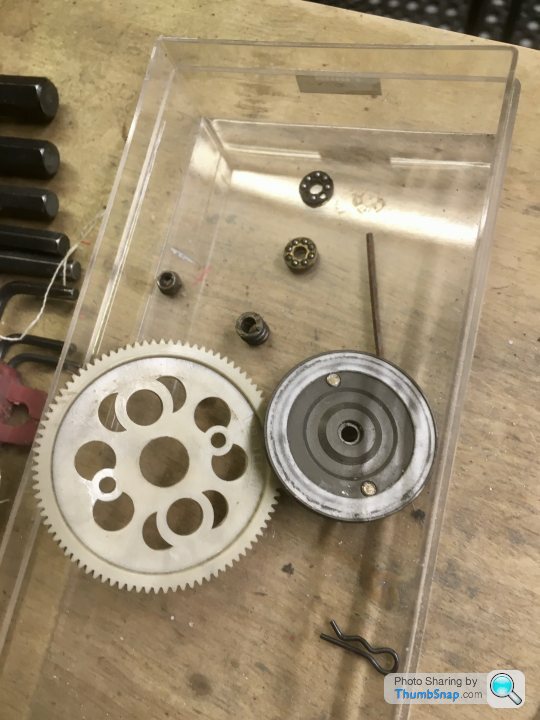
The other side of it presumably is removable, but we can’t get it off. The red side plates are bent, hopefully they can be straightened:
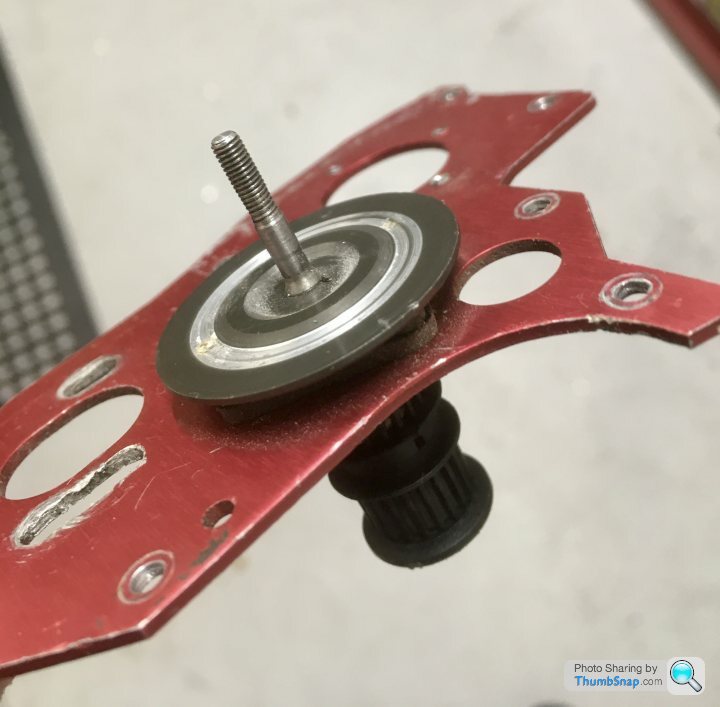
One of the original disc wheels is missing, but there’s a full set of spokes wheels, which are soaking in brake fluid to get rid of the terrible paint.
So it’s basically complete. Needs a few bits and a motor/ESC and batteries, and a body and undertray. Decent project.

Shocks aren’t original and seem knackered, so they’ll need replacing.
Also some of the ball races have lost their shields. Might as well get a full bearing kit.
Total mish-mash of fasteners, so they’ll need replacing too.
The carbon parts cleaned up nicely:

The pulleys have spacers on this one. The belt is damaged so will be replaced:

One of these pulleys is a bit chewed:

This is some kind of slip clutch, not sure what it’s for unless as a safety feature:

The other side of it presumably is removable, but we can’t get it off. The red side plates are bent, hopefully they can be straightened:

One of the original disc wheels is missing, but there’s a full set of spokes wheels, which are soaking in brake fluid to get rid of the terrible paint.
So it’s basically complete. Needs a few bits and a motor/ESC and batteries, and a body and undertray. Decent project.
TheBinarySheep said:
Wow this brings back memories. I'm sure I had one of these in the 90s.
In decent condition probably worth a couple of hundred quid on eBay. Probably almost as much as I paid for my new Schumacher laydown.
Thanks! Don’t think he’d sell it when it’s done, I think it might get used a bit then put next to his Mad Bull.In decent condition probably worth a couple of hundred quid on eBay. Probably almost as much as I paid for my new Schumacher laydown.
dr_gn said:
Thanks! Don’t think he’d sell it when it’s done, I think it might get used a bit then put next to his Mad Bull.
Have a look around for a 1/10th off-road club near you. There's plenty around the country that race both indoor and outdoor. There'll be people at those clubs who were around back in the 90's. We have three clubs no too far away from us, and I know they're always loads of people willing to provide help and advice.It's a great hobby, if a little expensive if you want o to try and keep up with the quick drivers.That's a nice little restoration project dr_gn.
The car is a Bosscat 'Competition' model, although the rear shocks are from the earlier CAT models and the front shocks look to be Kyosho Option House 'gold' shocks, which were the best ones around in their day.
I'm not sure about spares availability for the Kyosho shocks, but a rebuild kit is available for the others as they are (almost) identical to the re-release XLS and Top Cat models.
Belts are identical to the re-release XLS, so readily available.
The back place from the slipper clutch should just pull off the layshaft, so I guess there may be a little corrosion in there. There is a tiny steel pin though the layshaft which sits in a slot on the back of the plate - that will be the rusty culprit. Enough force applied with some sympathy to the red sideplate should get the plate off.
A replacement for the chewed up layshaft pulley will be difficult to find. You could try asking on the Vintage Schumacher facebook group. If it's not too bad, you might be able to tidy up the tooth edges with a scalpel to get more use from it.
Check the front one-way driveshafts. The plastic end piece usually cracks. There are 3D printed replacements available now or you can replace the whole driveshaft with the standard item from the re-release XLS.
There is a large choice of tyres from Schumacher in the 2.2inch size. If you're just bashing, then go for green or blue compound so they don't wear out so quickly.
Finally, the weak point is the crashback uprights on the Bosscat. They can either break off the pivot stub or the front angled part which holds the rubber band. So don't be tempted to lock off the crashback mechanism with zip ties.
Other than that, they are sturdy cars and great fun to drive.
The car is a Bosscat 'Competition' model, although the rear shocks are from the earlier CAT models and the front shocks look to be Kyosho Option House 'gold' shocks, which were the best ones around in their day.
I'm not sure about spares availability for the Kyosho shocks, but a rebuild kit is available for the others as they are (almost) identical to the re-release XLS and Top Cat models.
Belts are identical to the re-release XLS, so readily available.
The back place from the slipper clutch should just pull off the layshaft, so I guess there may be a little corrosion in there. There is a tiny steel pin though the layshaft which sits in a slot on the back of the plate - that will be the rusty culprit. Enough force applied with some sympathy to the red sideplate should get the plate off.
A replacement for the chewed up layshaft pulley will be difficult to find. You could try asking on the Vintage Schumacher facebook group. If it's not too bad, you might be able to tidy up the tooth edges with a scalpel to get more use from it.
Check the front one-way driveshafts. The plastic end piece usually cracks. There are 3D printed replacements available now or you can replace the whole driveshaft with the standard item from the re-release XLS.
There is a large choice of tyres from Schumacher in the 2.2inch size. If you're just bashing, then go for green or blue compound so they don't wear out so quickly.
Finally, the weak point is the crashback uprights on the Bosscat. They can either break off the pivot stub or the front angled part which holds the rubber band. So don't be tempted to lock off the crashback mechanism with zip ties.
Other than that, they are sturdy cars and great fun to drive.

dr_gn said:
Thanks very much for all the info Groomi. We’ll try to retain the shocks. What’s the idea behind the one way driveshafts? Is it to retain steering under braking or something? And what about the friction clutch? Is it to save overloading the transmission?
Cheers.
The friction clutch. We call it the 'slipper'. It's there to protect the transmission, but at the same time also allows you to adjust how power is delivered to aid traction on different surfaces. For example, with my 2wd I mostly race on carpet during the winter and astro turf in the summer, both are fairly high grip so you can tighten the slipper clutch so there there is very little slip. However, on slippery surfaces just as a gym floor, the same setup would make the car almost impossible to drive as you simply have no traction. One of the adjustments you can make is to loosen the slipper clutch to help smooth out the power delivery to the wheels. There's other things you can do as well including adjusting the power curve on the speed controller, but the slipper clutch is by the far the quickest adjustment you can make.Cheers.
TheBinarySheep said:
dr_gn said:
Thanks very much for all the info Groomi. We’ll try to retain the shocks. What’s the idea behind the one way driveshafts? Is it to retain steering under braking or something? And what about the friction clutch? Is it to save overloading the transmission?
Cheers.
The friction clutch. We call it the 'slipper'. It's there to protect the transmission, but at the same time also allows you to adjust how power is delivered to aid traction on different surfaces. For example, with my 2wd I mostly race on carpet during the winter and astro turf in the summer, both are fairly high grip so you can tighten the slipper clutch so there there is very little slip. However, on slippery surfaces just as a gym floor, the same setup would make the car almost impossible to drive as you simply have no traction. One of the adjustments you can make is to loosen the slipper clutch to help smooth out the power delivery to the wheels. There's other things you can do as well including adjusting the power curve on the speed controller, but the slipper clutch is by the far the quickest adjustment you can make.Cheers.
I believe the one-way driveshafts were originally supposed to help with steering on low grip surfaces and first featured on earlier cars without front diffs. They also mean you only have rear wheel braking, which can be a useful tool to 'handbrake turn' into a corner if you've made a complete fist of hitting the apex! It also helps to reduce weight transfer onto the outside front wheel if you lift off mid-corner, due to no motor drag on the front axle.
Gassing Station | Scale Models | Top of Page | What's New | My Stuff




